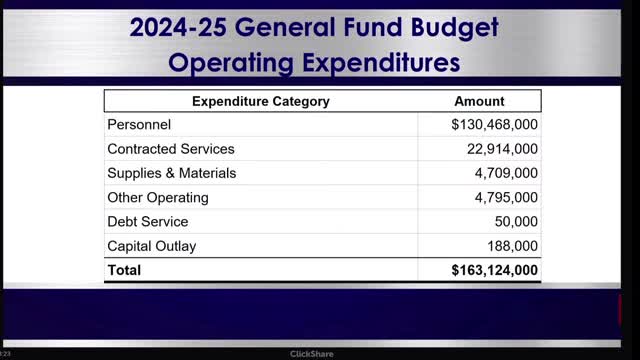School budget faces $11 million deficit amid rising costs
August 09, 2024 | SCHERTZ-CIBOLO-U CITY ISD, School Districts, Texas

This article was created by AI summarizing key points discussed. AI makes mistakes, so for full details and context, please refer to the video of the full meeting. Please report any errors so we can fix them. Report an error »

During a recent government meeting, officials discussed the upcoming budget for the next fiscal year, highlighting a projected deficit of $11 million. The total expenditures are estimated at $163 million, with a significant portion allocated to personnel costs, including contracted services for substitute teachers and school resource officers (SROs).
The budget breakdown reveals that approximately $100 million is earmarked for instructional services, which encompasses professional development for teachers and administrative support. Other categories include student support services, maintenance, and information technology, with the latter seeing increased costs due to new legislative requirements for SROs on every campus.
Officials noted a 3% pay raise for staff and a shift in health insurance providers from United to Aetna, which is expected to mitigate some cost increases. However, the district faces challenges with funding, particularly as it transitions away from federal ESSER funds, which had previously supported various programs and personnel.
The anticipated operating deficit of $5.3 million is concerning, marking a significant increase compared to previous years. Despite this, officials expressed confidence in their fiscal management, stating that historical spending trends suggest the actual deficit may be lower than projected. The district's unassigned fund balance is expected to remain above the board's policy target, although it will decrease over the next few years if spending trends continue without additional revenue.
Looking ahead, the upcoming legislative session in 2025 is critical, as any potential funding increases from the state would not impact the current budget but could alleviate future deficits. Officials emphasized the importance of monitoring legislative developments, particularly regarding any unallocated funds from the current biennium that could be redirected to support school budgets.
The budget breakdown reveals that approximately $100 million is earmarked for instructional services, which encompasses professional development for teachers and administrative support. Other categories include student support services, maintenance, and information technology, with the latter seeing increased costs due to new legislative requirements for SROs on every campus.
Officials noted a 3% pay raise for staff and a shift in health insurance providers from United to Aetna, which is expected to mitigate some cost increases. However, the district faces challenges with funding, particularly as it transitions away from federal ESSER funds, which had previously supported various programs and personnel.
The anticipated operating deficit of $5.3 million is concerning, marking a significant increase compared to previous years. Despite this, officials expressed confidence in their fiscal management, stating that historical spending trends suggest the actual deficit may be lower than projected. The district's unassigned fund balance is expected to remain above the board's policy target, although it will decrease over the next few years if spending trends continue without additional revenue.
Looking ahead, the upcoming legislative session in 2025 is critical, as any potential funding increases from the state would not impact the current budget but could alleviate future deficits. Officials emphasized the importance of monitoring legislative developments, particularly regarding any unallocated funds from the current biennium that could be redirected to support school budgets.
View full meeting
This article is based on a recent meeting—watch the full video and explore the complete transcript for deeper insights into the discussion.
View full meeting
